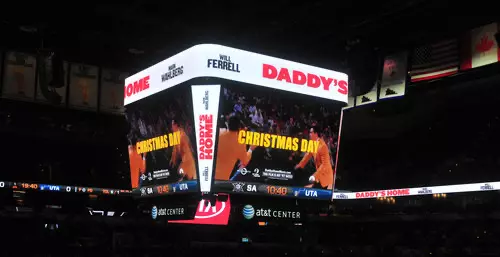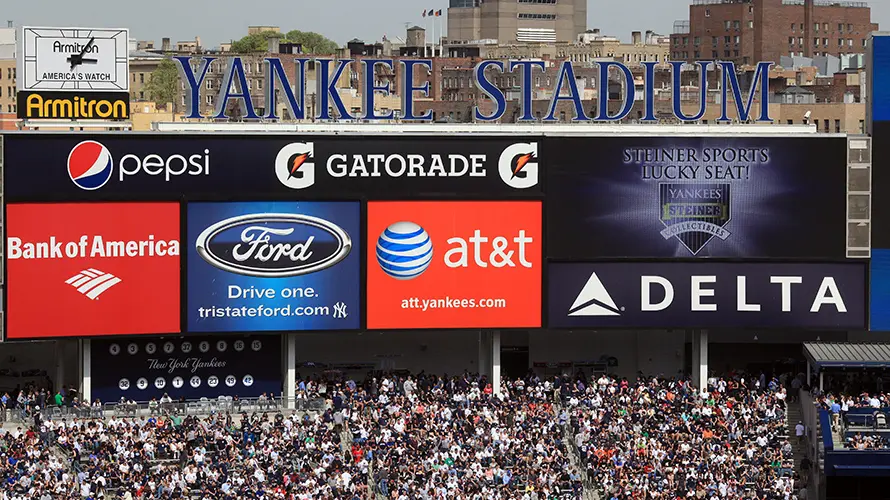Many large-capacity stadiums can fit nearly 100,000 spectators, making them the perfect place to spread your brand’s message. Because different events cater to different crowds, you can plan a marketing campaign that will reach a broad swath of the general population.
If you’re thinking of incorporating stadium advertising into your next marketing campaign, you probably know that it is a great way to make sure your message is seen by hundreds of thousands of people. Let’s go over the basics.
What Is Stadium Advertising?
Stadium advertising involves the production and display of ad content on stadium walls and furniture. On a smaller scale, these might be signs advertising your business through sponsorships at a minor league baseball game. On a larger scale, it could be a digital display ad that is shared during a MLB game. Because many sports events are broadcast on national television, your ad has the potential to travel far beyond the confines of the stadium, reaching millions of viewers.
Sports fans are a varied bunch, and the right sports venues for your ad will depend on the demographics you hope to target. Stadium ads often reference the specific sports played at the venue. For example, an ad placed in Staples Center will be seen by NBA fans, and will often reference basketball specifically. If you want to target a local demographic in New York, you might design content geared towards Mets fans. Stadium advertising gives you a wide degree of latitude when it comes to targeting demographics and how you can best reach them.
Beyond just hosting sports leagues, many sports facilities also host concerts and other entertainment events, ensuring that your content will be widely seen even when there are no games on the docket.
How Does Stadium Advertising Work?
When it comes to stadium advertising, there are a lot of options to choose from. Your ad content could appear on banners that line the walls or hang from court ceilings, it could appear on posters and kiosks throughout concourses and entryways, or you could design sponsored ad content that appears on the game scoreboard.
Remember that sports fans are notoriously territorial, so if you’re designing content that is geared towards a specific demographic (New York Mets fans, for example) make sure your content appears on the home town scoreboard and not the opposing team’s scoreboard or dugout.
Many stadiums have a high degree of technological proficiency and savvy, and you have the option to create digital content that will be displayed on scoreboards. As fans turn to the screens to see replay screen shots, your branded ad content will get your message out to a highly engaged and excited audience.
What Is The Cost Of Advertising In Shopping Malls?
Since mall advertising can take on so many different formats, from static images, to backlit dioramas, to digital screens, costs are hard to nail down. You can expect pricing to be in line with other outdoor advertising and DOOH ad spends. Size and format will factor into your ad pricing. Typically, table tops ads in the food court are on the lower end of the cost spectrum. Banner ads and larger wraps are on the high end.
Additionally, location is going to be a key factor in ad spend. Shopping malls with more patrons will have a higher price tag than less popular shopping centers. Malls in more rural areas will have cheaper pricing options.
Length of ad time is also a factor in cost. Most mall ad buys last four weeks, though the duration of an ad can vary. Ads placed during busier seasons will also be more costly. Factor in seasonality when you plan your campaign. Malls are busier during the holiday seasons so prices can be higher during that time.
Your content can run for the entire season, or in some cases you can choose a shorter duration.
What Are The Benefits Of Stadium Advertising?
Stadiums draw massive crowds, and the activities that take place there are usually broadcast to a much wider national audience. Whether it’s attendees posting selfies on social media, or national sports media coverage, your stadium ads will travel far beyond the confines of the stadium itself. Like billboards, stadium ads are eye-catching and widely seen by a broad swath of the public.
You may be able to do some degree of targeting by choosing the venues and placement of your ads. But keep in mind that sports events draw crowds from far and wide, and often have broad viewership outside of the geographic vicinity. Take the Super Bowl, for example. Although it might take place in a specific city, the ads placed in the stadium are seen by millions of viewers internationally. To effectively make use of stadium ads, you should consider how many people will view your ad beyond the immediate geographic location.
What Are The Different Types Of Stadium Advertising?
Many different venues offer advertising options. This incudes professional sports, like the NFL, NHL, MLB and the NBA. But many smaller sports leagues also offer sponsorships and signage opportunities. These may include college sports leagues or even local high school sports. The latter are especially effective for small local businesses, because the audience is highly localized and the sponsorships are typically much more affordable.
Your actual ad can appear in many different places within the stadium, whether it’s the court or field itself, or the surrounding hallways and concourses. Different placements will carry different price tags, so work with a reputable advertising company to find the ad design and placement that works for you.
How To Get The Most Out Of Your Stadium Ads
You know that stadium ads offer massive exposure to your ad content. If you want to get the most out of your stadium ads, you need to consider the viewership and the demographics you want to target. If your product or service is highly localized, you may want to partner with a local sports league that attracts viewers from nearby communities. If you’re trying to gain national exposure, you should plan to place your ad in a major league sports stadium.
If your ad is featured in the heat of the action, like on a courtside banner, your content will be seen by a much wider audience that if it’s placed in the concourses surrounding the court. Remember that spectators will post a lot of photos on social media, so ad content that is interactive or points to your social media channels will be highly effective. Content that promotes any sponsorships or partnerships you have with the local team will also be viewed positively by the local sports fans.
How To Properly Design A Stadium Ad
When designing a stadium ad, you should first determine where the ad will be placed. Work with the venue to determine any location and sizing restrictions, and whether your ad will be static or digital. Determine how long you want your ad to remain in place, whether it’s for the entire season or just a few weeks.
Sports fans love content that promote their local team. They often become fiercely loyal towards brands that sponsor or otherwise partner with their team. For example, Dunkin Donuts has long been associated with the Boston Red Sox and offers many promotional deals to Red Sox fans. These types of special offers and partnerships endear brands to local residents, so consider how your ad can incorporate the sports team most effectively.


